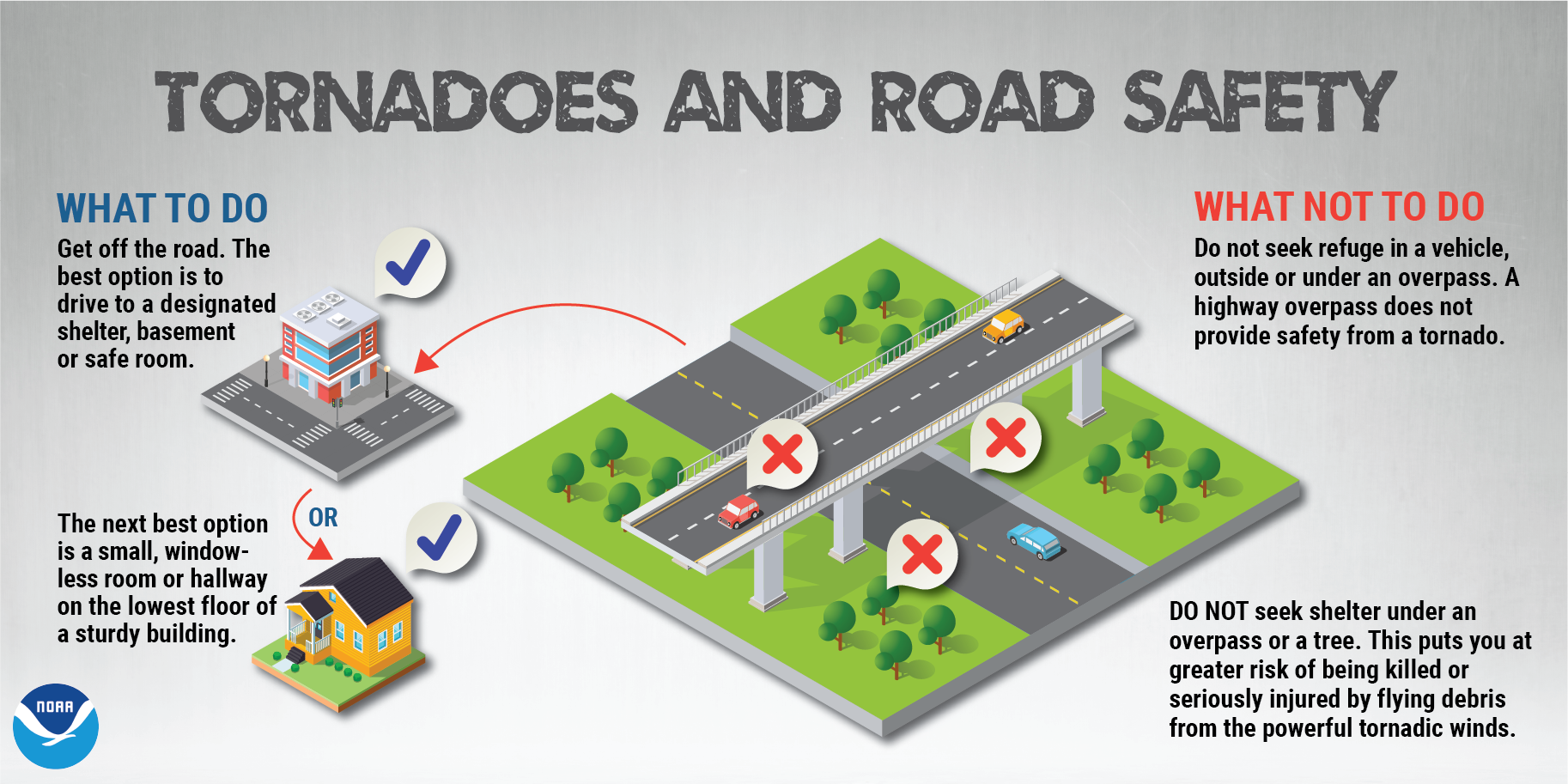Severe Weather Awareness - Tornado Safety
With Meteorological Spring beginning on March 1 and the Spring Equinox coming up quickly, March 20, 2022, we wanted to provide safety tips and reminders regarding various severe weather types, including tornadoes, severe winds, hail, lightning, and flooding. The first of these that we will talk about is tornado safety.
While tornadoes can technically happen any time of the year, we often see the peak of this activity occur while our climate transitions from Winter to summer over the next few months. This threat usually begins in the southern United States and shifts slowly northward as warmth and moisture shift north across the country. Already this year, though, we have seen the tragic impacts tornadoes can bring, with an EF-4 tornado ripping through the small town of Winterset, Iowa, killing six and injuring five people. The Winterset Iowa tornado is the first EF-4 tornado rated EF-4 since 2013 in northwest Iowa. This tornado was also the second-longest track tornado in Iowa since 1980. So far this year, we have already had eight fatalities due to tornadoes, and we have not even hit our peak tornado months yet. The month with the most deadly tornadoes in the United States is April. While we see the overall most tornadoes in the United States during the month of May. Finally, the month with the most tornado days - that is days where we see at least one tornado - is June.
Do you know the difference between a Tornado Watch and a Warning?
The best way to remember the difference between a Tornado Watch and a Tornado Warning is to think of it like preparing a taco. A Tornado Watch is issued when all the ingredients are there for the development of tornadoes; they just have not come together yet. When a tornado watch is issued, the time to prepare for a tornado threat is now. For the preparation, having multiple ways to receive weather alerts is very important and is something we will cover more at the end of this article. You will want to also have a plan in place on where to go if a warning is issued. Within that place of shelter, you should also have backup medication, water, a first aid kit, spare money, a flashlight, and any essential documents.
If a Tornado Warning is issued, then the tornado threat is ongoing. You have put the beef, lettuce, and tomato on your taco, and you’re ready to eat it. If a tornado warning is issued for you, take shelter immediately in your safe place and wait until the threat has passed.
Graphic from the NWS in Albuquerque, New México
Safe places to seek shelter during a tornado warning
When it comes to seeking shelter during a tornado warning, there are various potential options depending on where you are. In this next section, we will break down some of the safest choices you can make depending on where you are, and then finally, in the end, talk about some of the worst places to try and take shelter.
Home
We will start with your residence. If you are under a tornado warning and you are at home, some of the most common safe places you hear mentioned when we say take shelter are in the basement - away from windows, and often in a re-enforced room like under the stairs, closet, or bathroom - and a storm shelter. If your home has these options, these are excellent choices! Many are not that lucky, though, so what are some safe alternatives? If your home or residence does not have a basement or storm shelter, your next best option is to get to the lowest level and find a reinforced room like a closet, stairs, or bathroom in the middle of the building. To minimize your chances of being injured from debris flying through a window or exterior wall. If you cannot find a window without any windows, the next best option is to try and put something in the window or cover yourself from flying debris. Some possibilities would be blankets, pillows, couch cushions, and even a mattress. Often, you will also hear people say to take shelter in your bathroom tub. Taking refuge in a bathtub was more true back in the day when they were made of metal or steel, but again, putting walls between you and the outside never hurts.
Apartment, Hotel, Multi-floor Building
If you are in a hotel or apartment building, you want to try to get to the lowest level of the building, which could be the basement or parking garage. Another alternative is seeking refuge in a stairwell, bathroom, or storage room in the middle of the building. If you cannot make it to the lowest level of the building in time, we recommend getting as close to the center of the building as possible. You again want to put as many walls between you and the outside as possible. Some examples of places to go or find would be the bathroom or interior hallway away from windows. Remember to bring a flashlight with you if possible and avoid using the elevator as the odds of losing power and getting stranded are high!
In a Vehicle
If you are in a vehicle when a tornado warning is issued, first, don’t panic. Pull the vehicle over in a safe place and check the warning to see where the tornado is regarding your location. If you can physically see the tornado, watch it briefly to get an idea of the direction of motion. If the tornado is getting smaller, it is going away from you. If it is getting bigger, it is moving towards you, and you need to take action NOW! Not panicking and seeing where the tornado is and where it is going are the most important things you can do because you do not want to be in an area that was technically safe and then drive into the path of the tornado trying to seek shelter. If you are not in the path of the tornado, remain where you are and continue to monitor where it is tracking to make sure it does make a turn towards you. If you happen to be in the path of the tornado, find your nearest place to seek shelter. A bank, library, or sturdy building would be an excellent choice! Try to avoid big box stores, as they tend to have a higher risk of collapse due to their very open floor plans.
If you cannot find a sturdy building and the tornado is coming straight towards you, you can attempt to outrun it by going perpendicular to the direction it is tracking. DO NOT EVER SEEK SHELTER UNDER AN OVERPASS OR TREE! When you choose this option, you are increasing your odds of injury or death and could also increase your odds of hampering other people’s lives by blocking the road by stopping under an overpass. Your LAST option is it get out of your vehicle and lay in a ditch/low lying area while covering your head. If you go this route, make sure you do it away from your vehicle as it could get blown over or rolled on top of you. Do not go inside an actual culvert, though, as there could be a high chance of flooding and drowning.
Camp Ground (Tent), Camper, or Mobile Home
If you are going to be at a campground, in a camper, or a mobile home, the first thing you should do when arriving at a location is find your nearest shelter. Whether by asking staff at the camp round or simply looking at a map, you should know where your two closest shelters are and how long it takes to get to said shelters. Since the time to seek refuge is likely the best time, add 15 to 20 minutes onto that time to account for any delays that might occur. No matter what, never stay in your mobile home, tent, or RV during a tornado. You have better odds of surviving a tornado is if you lie flat on low ground away from your home, protecting your head. If possible, find an area that is open away from trees and cars; to avoid them being blown onto you.
Multiple Sources for Severe Weather Alerts
It is crucial to have multiple sources to receive severe weather alerts if one of your means of receiving alerts doesn’t work or dies. One of the most important resources you should have is NOAA Weather Radio. I like to consider the weather radio your fire alarm for severe weather and are proven to save lives, especially during severe weather events that occur at night. Below this paragraph, you will find a link to a weather radio that I highly recommend and personally own. The following resources can be a combination of things, including the TV/local news, local news station app, phone/text alerts, or other various phone apps, and social media. Social media can be tricky, though, as multiple media platforms can have algorithms that might not allow you to see the post first or right away. So I would not recommend that being your initial source for alerts, but more of a way to get additional information or see a map of whatever inclement weather that might be going on.
You might notice that I did not mention tornado sirens in this list, as tornado sirens are ONLY meant for outdoor use. It would be best not to rely on hearing a tornado siren to alert you to an ongoing tornado threat while you are indoors. We can not guarantee that you will hear the sirens indoors. Again, this is why we recommend having a weather radio!
Tornado Myths
Over the years, several weather-related myths have sprung up on various social media platforms. I wanted to wrap up this article by touching on a few of them and hopefully educating some of you on why they are false.
Myth #1: You should open your winds for a tornado.
Answer: FALSE! This myth originated when people thought that opening your windows would help equalize the pressure. People thought that would reduce how much damage might occur to your home during a tornado by decreasing the pressure. They later learned that the horizontal and vertical winds within the tornado cause the damage. Opening your windows during a tornado will increase the risk of collapse and damage by weakening the structure.
Myth #2: I live in a valley, in the hills, by a river or body of water, so tornadoes can’t or won’t happen here.
Answer: FALSE! Time and time again, this myth has been proven wrong. Valleys, bodies of water, or hills do not prevent tornadoes from occurring, nor do they stop tornadoes stop them if they are already in progress.
Myth #3: I live in the city, and tornadoes never happen in the city.
Answer: FALSE! This is another myth that has been proven wrong on several occasions, especially over the last year. We had several night-time tornado outbreaks in the downtown of several large cities, including; Nashville, Oklahoma City, and Cleveland, to name a few.
Myth #4: You should seek shelter on the southwest corner of your residence.
Answer: FALSE! This myth came around when people assumed tornadoes only came from the southwest, but we quickly learned tornadoes could come from any direction over the years. Going back to what we mentioned earlier, it is also crucial to put as many walls between you and outside.




